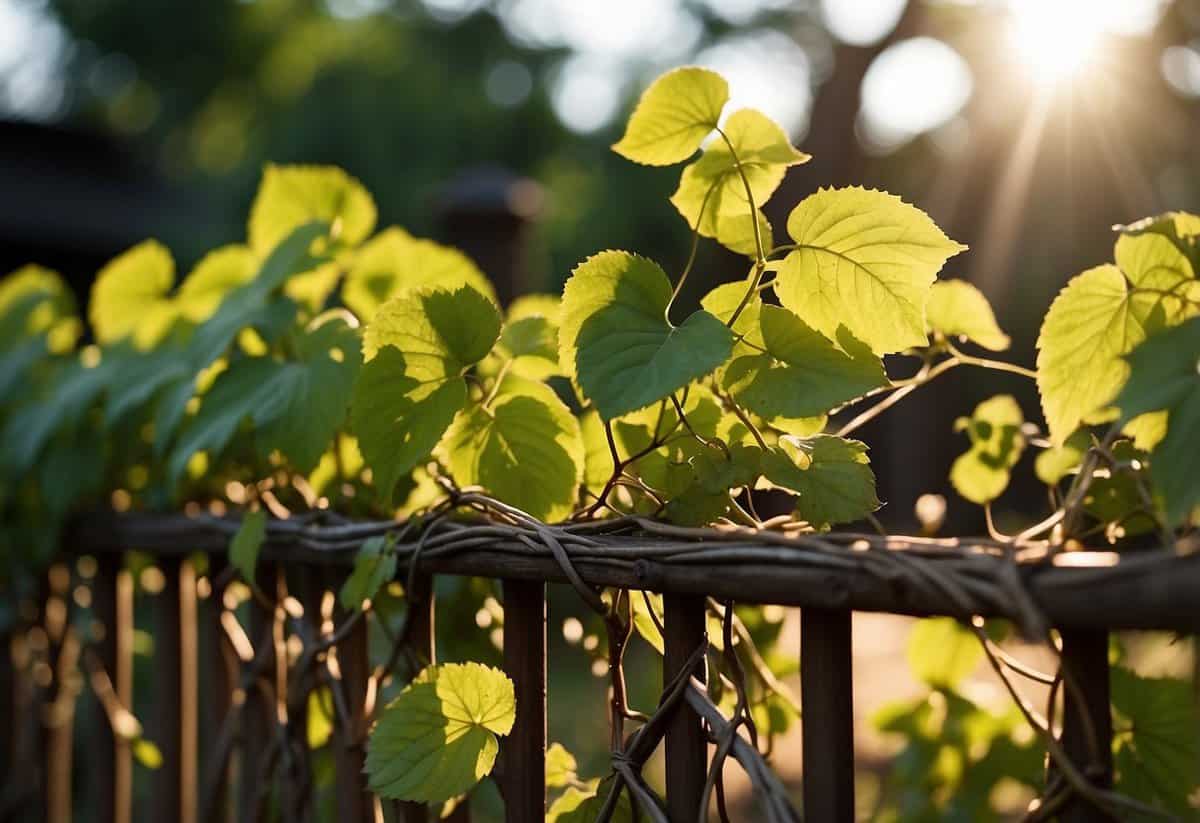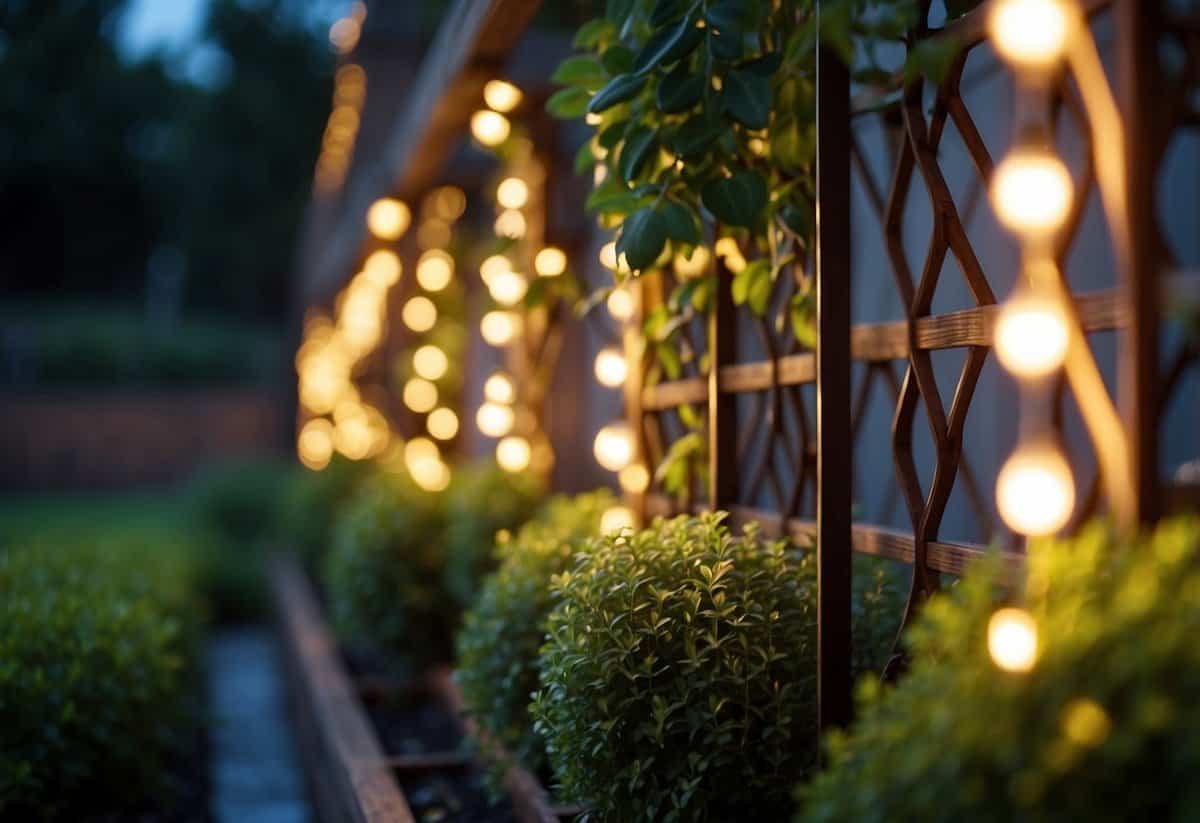Garden Trellis Tips: Easy Ways to Enhance Your Outdoor Space
Gardening can be a rewarding way to brighten up your outdoor space, and adding a trellis can elevate your garden’s appeal. A trellis not only serves a functional role but can also bring a touch of charm and beauty to your garden. Are you ready to transform your garden into a lush, green haven?

In this article, you’ll find tips that will help you choose the right trellis for your garden and get the best results from your climbing plants. Whether you have a large backyard or a small patio, there’s a trellis solution that’s perfect for you.
1) Choose the Right Materials

When selecting materials for your garden trellis, it’s important to think about durability and appearance.
Bamboo offers a natural look and lasts a long time, making it an excellent choice.
Metal trellises, like those made from aluminum, are strong and can add a modern touch to your garden.
Vinyl trellises are low maintenance and available in many styles, fitting different garden aesthetics. For more detailed guidance, check out these best materials for a trellis.
2) Install Post Anchors Correctly

To ensure your garden trellis stands firm, you need to install post anchors correctly. Start by selecting the right spot. Consider sunlight and soil drainage.
Dig holes about 2 feet deep for each post. Place the posts into the holes and use a spirit level to keep them straight.
Backfill the holes with post mix, following the instructions on the bag. Make sure the posts are stable before attaching your trellis. For more details, check out this guide on using posts.
3) Opt for Weather-Resistant Paint

Using weather-resistant paint on your garden trellis can extend its lifespan. It helps protect the wood from rain, sun, and wind.
Start by sanding the wood with medium-grit sandpaper to ensure the paint adheres well.
Wipe the trellis with a damp cloth to remove any dust before painting. Then, apply a coat of weather-resistant paint for a durable finish.
For more prep tips, visit Painting a Wooden Trellis.
4) Incorporate Climbing Plants

When adding climbing plants to your garden, consider using plants like climbing roses, clematis, and jasmine. These can easily accentuate trellis features and create beautiful focal points in your garden.
Training your plants is essential for their growth. You can use garden twine or soft ties to guide the young shoots towards the trellis.
For a unique look, experiment with different plant combinations. Mixing various textures and colors can lead to dynamic and eye-catching displays. Using a diamond-patterned trellis can add an eclectic touch to your space.
5) Ensure Proper Sunlight

Position your trellis where it can get plenty of sunlight. A north-to-south orientation is ideal as it allows your plants to get sunlight throughout the day without casting too much shade on other parts of your garden.
Make sure the area you choose gets at least six hours of direct sunlight daily. This is crucial for plant health and growth.
Consider the specific needs of the plants you are growing on the trellis. Some plants might need more sun than others. Planning ahead ensures your plants thrive all season long.
6) Consult a Gardening Expert

Reaching out to an expert can save you a lot of trial and error. They can provide personalized advice tailored to your garden’s specific needs.
You might find an expert through local gardening clubs or online forums. Many experts also offer workshops and private consultations.
By seeking expert advice, you’ll gain confidence and learn valuable tips to help your plants thrive.
7) Use Quality Fasteners

When setting up your garden trellis, always use quality fasteners. Good fasteners ensure stability, keeping your trellis sturdy and secure.
Opt for rust-resistant materials like stainless steel or coated screws. These materials withstand weather conditions and last longer.
Don’t underestimate the importance of tight connections. Secure fasteners tightly to prevent wobbling and support your plants effectively.
8) Implement Creative Designs

Think outside the box when designing your garden trellis.
You can use materials like old doors, windows, or recycled wood to give a unique touch.
Consider painting your trellis in bright colors to make it stand out.
For a fairy-tale look, you can even add climbing roses or ivy.
Using decorative elements such as copper slats can enhance the visual appeal of your trellis (Architectural Digest).
9) Consider Trellis Height

When setting up your garden trellis, it’s important to think about the height. A trellis that’s too short won’t support your climbing plants properly.
Make sure the trellis height matches the mature size of your plants. For example, tomatoes and beans need taller structures, while peas can do with something shorter.
Also, remember that a taller trellis can cast shadows, which might affect other plants nearby. So, pick a height that suits both your garden space and your plants.
10) Integrated Lighting Solutions

Adding lighting to your garden trellis can create a magical evening atmosphere.
Use solar-powered LED lights or low-voltage landscape lighting to highlight the structure.
Experiment with uplighting or downlighting to accentuate the plants and create a luminous effect, making your garden a welcoming place to relax after dark.
You can find more ideas on garden lighting.
Choosing The Right Trellis

Choosing the right trellis involves knowing the types of trellises, their materials, and how to size and place them. Here’s what you need to know to make the best choice for your garden.
Types Of Garden Trellises
Grid Trellises: Made of wood or metal panels, grid trellises are great for privacy and defining spaces. They can be freestanding or anchored to a wall.
Arched Trellises: These are perfect for creating entryways or pathways. Often used to support flowering vines.
Obelisk Trellises: These stand-alone trellises add vertical interest and suit smaller gardens.
Fan Trellises: These spread out like a fan and are ideal for climbing roses or other spreading plants.
Material Considerations
Wood: Wood trellises provide a natural look and blend well with garden landscapes. They are sturdy but may need treatment to resist weather.
Metal: Metal trellises, like those made from iron or aluminum, are durable and can offer a classic or modern appearance. They might need occasional rust prevention treatments.
Plastic: Plastic trellises are lightweight and weather-resistant. They often come in various colors and require minimal maintenance.
Vinyl: Vinyl is another durable, low-maintenance option. It’s resistant to elements and doesn’t need painting or sealing.
Size And Placement
Size: When choosing the size, consider the plant’s mature height and spread. Ensure the trellis can support the plant as it grows.
Placement: Place your trellis where your plants will get enough sunlight. For example, south-facing spots are often ideal for sun-loving plants.
Stability: Ensure the trellis is firmly anchored, especially if it’s supporting heavy plants. Freestanding trellises need more support than those fixed to walls or fences.
Aesthetics: Think about how the trellis will look in your garden. Choose designs that complement your garden’s style and the surrounding landscape.
Plant Selection For Trellises

Choosing the right plants for your trellis can turn your garden into a stunning space. Think about climbing plants for coverage, flowering vines for color, and edible plants for function.
Climbing Plants
Climbing plants are ideal for trellises because they naturally want to climb and spread. Varieties like ivy and clematis use their tendrils or suckers to hold onto the structure. You’ll find that ivy is excellent for creating dense, green walls. Clematis, on the other hand, provides beautiful blooms that come in various colors.
Morning glory is another great choice. It produces vibrant flowers and can quickly cover a trellis. If you’re in a hurry to fill a space, morning glories are fast growers. They thrive in full sun and well-drained soil.
To ensure success, make sure your trellis is sturdy enough to support the weight of these plants as they grow. Proper installation is key to having a long-lasting and beautiful trellis.
Flowering Vines
Flowering vines add a burst of color to your garden. Star jasmine is a popular choice due to its fragrant white flowers that bloom with plenty of sunlight. It’s perfect for warmer zones, ideally 8 to 10, though it can tolerate zone 7 with some winter protection.
Black-eyed Susan vine is known for its striking yellow and orange flowers. This plant can grow up to 10 feet long, making it ideal for a trellis. It’s a vigorous climber that makes an attractive screen or backdrop.
Trumpet vine is also remarkable with its trumpet-shaped flowers that hummingbirds love. This vine prefers full sun and can grow quite tall. It’s perfect for covering large trellises and adding vertical interest to your garden.
Edible Plants
Edible plants are a practical choice for trellises. Tomatoes do well with trellis support, especially varieties like cherry tomatoes. They benefit from the structure, which keeps the fruit off the ground and improves circulation.
Cucumbers are another excellent option. They can climb a trellis with their curling tendrils, making them easier to harvest and less prone to pests. Providing ample sunlight and regular watering will yield a good crop.
Pole beans also thrive on trellises, reaching upwards as they grow. This not only saves space but also makes picking beans easier. Make sure to plant them in well-drained soil and give them lots of sunlight.
Choosing the right plants for your trellis depends on your goals, whether you want visual appeal, practical use, or both. Enjoy experimenting with different plants to create a garden that suits your needs and tastes.







